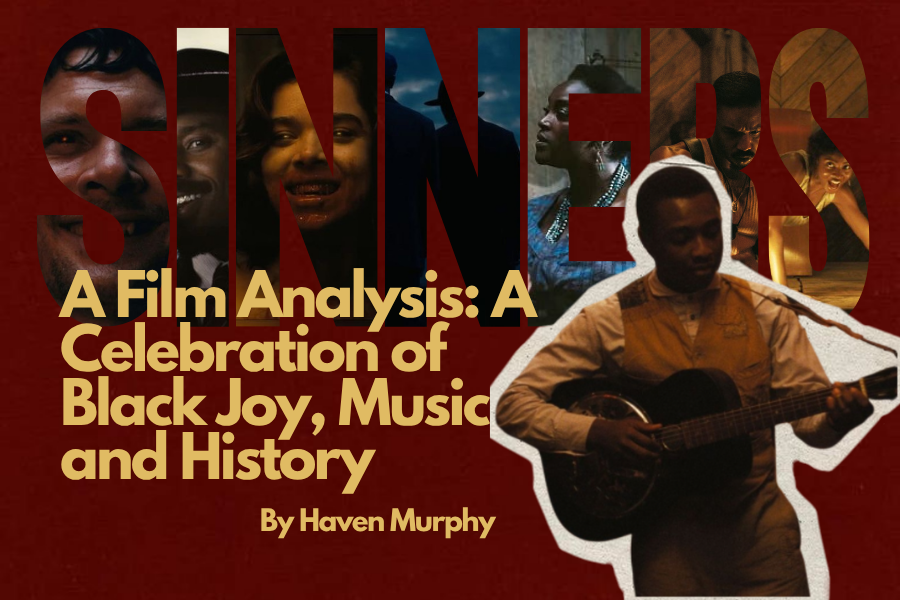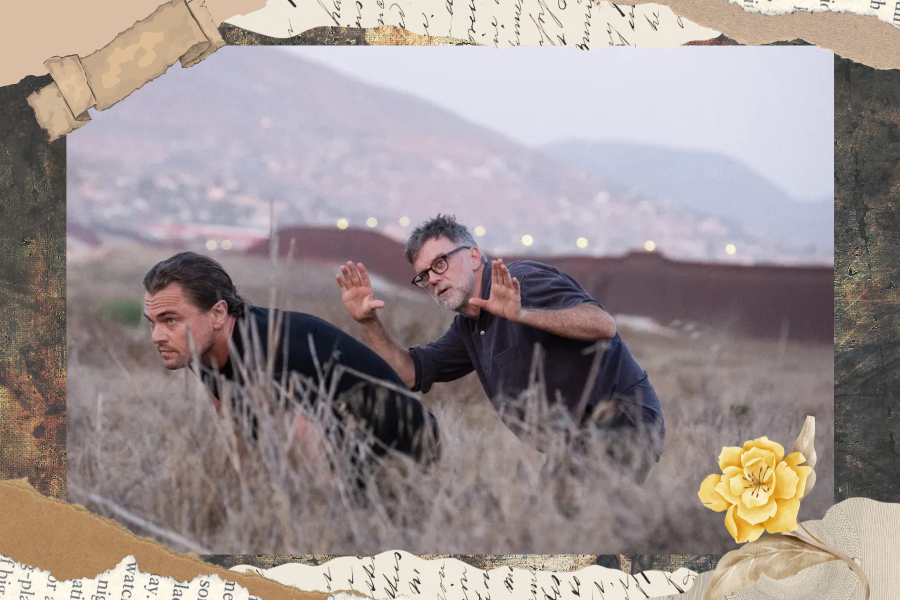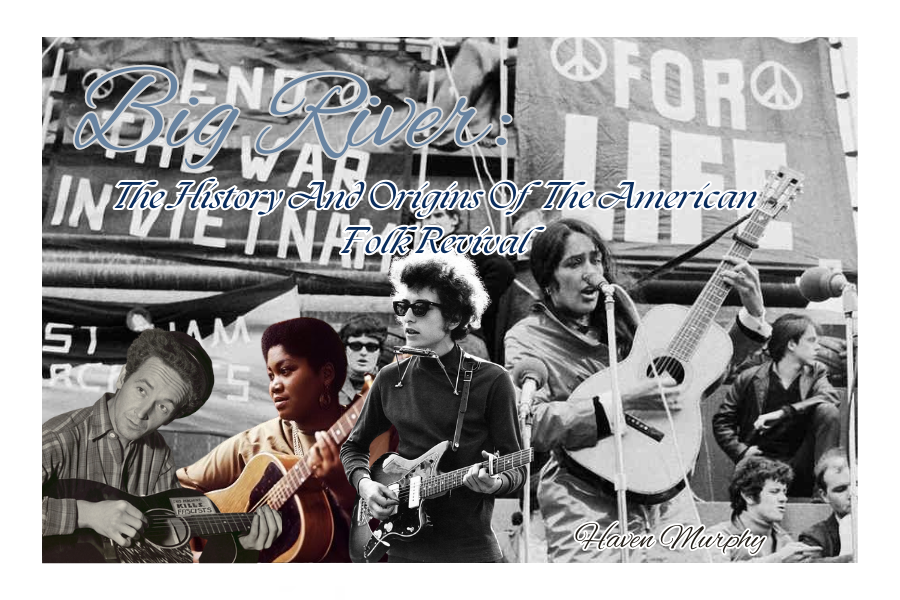“Sinners” directed by Ryan Coogler premiered April 17, 2025. I saw it in theatres for the first time on May 11, and on my way out, I knew it would not be my last. “Sinners” is marketed as a vampire horror film set in the early 1930’s. However, it is not simply just a vampire horror film. Yes, there are vampires and horror elements like gore and jumpscares. Described as “genre-fluid” by Coogler, the film is also a thrilling drama that dances on the edge of a musical, celebrates black joy, livelihood and freedom and the use of the supernatural to symbolize the effects of colonialism and forced assimilation.
For many years in the film industry, films about or for black Americans have always been unlike others in many ways. Whether it is improper representation or a sole focus on the hardship of black people–which is not a bad thing, acknowledgement and commentary on social and systemic discrimination is important to be spoken about out loud to recognize not just history but the discrimination that occurs today against the black community.
However, when the majority of films with black casts and stories, marketed to the black community, do not get the opportunity to explore other themes and genres, such as the supernatural, healthy romance, sci-fi and even happiness, an uncomfortable box is created. Black films are expected to be a certain way, solely based around hardships black people have faced and currently face, and even stereotypes. “Sinners” is the perfect example of a film that is not shoved into the uncomfortable box. Not only is it not limited to only portraying black hardship, but it explores numerous genres that many black films are unable to successfully. Even though the film is set in the South during the Jim Crow segregation era of America, it is not the sole focus of the story. Instead, the story taking place in the Mississippi Delta sets for one of the root focuses of the film–the music.
From early moments of the film, one of the main characters, Sammie or “Preacher Boy,” [portrayed by Miles Caton] is seen working as a sharecropper. After he completes his quota, he goes for his guitar–only to find that his father [Saul Williams] has it. His father, the local pastor, warns him that if Sammie continues to, “Dance with the devil…one day he’s gonna follow you home.” During this time for many, blues music was seen as “the devil’s music.” However, Sammie’s desire for the music does not falter, he sees the art and self-expression as freedom. For just one day, he wants to be free of his hardship, including religion. At the end of the film after the bloody events at the Juke Joint, Sammie’s return to the church with the remains of his guitar in hand symbolizes this freedom and desire remaining, even though his life and numerous others were threatened for his musical abilities. He did not allow himself to become a victim to assimilation, whether it was at the hands of his father or the claws of the vampire.
Music is used as a method of comfort and portrayal of freedom. In a scene with Delta Slim [portrayed by Delroy Lindo], he recalls a traumatic story of his friend being lynched by the Ku Klux Klan. He begins to hum, symbolizing the trauma and pain that are expelled in the form of music, specifically, the blues. When describing Slim’s traumatic experience, Coogler does not show the trauma of the characters [outside of the visible Juke Joint event], similarly to how he does not show the Klan members clad in white robes but their own selves, he only recounts it. This emphasizes the fact that the character’s trauma does not need to be seen and made to be the primary focus of the film in order for it to be understood. Hearing a character’s [off-screen] trauma from themselves and how they experienced, rather than seeing it occur, shines light on them and how their trauma affects them rather than anything else.
The first act of “Sinners,” follows Sammie, the Smoke Stack twins [portrayed by Michael B. Jordan] and the formation of the Juke Joint. Throughout gathering musical acts, crews to put together the Juke and old lovers, the audience is introduced to central characters Delta Slim, Annie [Wunmi Mosaku], Mary [Hailee Steinfeld], Pearline [Jayme Lawson], Grace and Bo Chow [Li Jun Li, Yao] and Cornbread [Omar Miller]. The settings some of the characters are first introduced in reflects the era. Cornbread is a sharecropper, the first scenes of Pearline and Mary are at a train station where segregated restrooms are visible in the background and as the twins, Sammie and Delta Slim drive to the joint, they drive past a chain gang. Chain gangs were groups of convicts–mostly black men–forced to work hard labor such as road construction, ditch digging or farming, all while chained together.
In an economic study published by Howard Boddenhorn, it is shown that black men were far more likely to be charged with crimes than white men, and even when both black and white men were charged with a crime, white men found guilty were more likely to pay fines, and black men found guilty were more likely to serve a term at hard labor. After emancipation in 1865, reparations and new opportunities were not given to newly freed slaves, instead they were forced to work for the same plantations and systems they were freed from for any kind of financial earning due to targeted laws and systems set in place. Coogler’s inclusion of historical accuracies format a real-life setting of life for black Americans and people of color in the ’30s, building up to the climax of celebration at the Juke Joint.
When the vampires appear shortly after the Juke Joint takes off, act two of the film begins, and so does the beginning of the end for the Juke. One particular vampire is beckoned by Sammie’s guitar and powerful voice piercing the veil between the living, dead, past, future and present of African and Chinese culture. However, before the vampire’s arrival to the Juke, the audience is introduced to the central antagonist–Remmick [Jack O’Connell] as he is weak and battered, running from the Native American Choctaw tribe. Historically, the Irish and Choctaw share a relationship. In the midst of the forced removal and relocation of Native American tribes to the west [known as the Trail of Tears], the Choctaw donated money to Ireland during the potato famine, a devastating potato crop blight and denial of nutritional food sources to Ireland by England.
He pleads on the doorstep of a home owned by two KKK members, Joan and Burt [Lola Kirke and Peter Dreimanis]. However, this fact is hidden until Remmick sees the white robes in their home. Now, his once respectful demeanor regarding the Choctaw changes to align with the views of the couple, manipulating them into letting him in. Remmick is a more than 1000-years-old Irish vampire, presumably traveling the world looking for a way to connect with his ancestors. He spends most of his posthumous life as a vampire searching for this connection to contact his ancestors because he originates from 5th century Ireland, when it had not yet been Christianized and colonized.
The historical colonization and force of Christianity upon the Irish is represented through Remmick, as well as the effects of such inhumane force. He attempts to make friends with those in the Juke Joint in order to get to Sammie, only to use his body and musical ability to reconnect with his own ancestors and lost culture. Remmick as a vampire symbolizes a cycle of abuse–he perpetuates the same forced assimilation and abuse his own people experienced under a guise of an opportunity of outliving racism and “fellowship,” and the fact that “it was only going to happen anyways,” in reference to providing a “better option” than the Ku Klux Klan planning to show up at dawn. Remmick’s idea of fellowship is not as he says it is. He robs other’s of the humanity he longs for to build a community replicating the one of his heritage and life before becoming a vampire. This is evident in the Irish jig circle scene as he belts “Rocky Road To Dublin” and dances a traditional Irish step dance while all of the people of the Juke that he has turned surround him, clapping and singing along. As the song concludes, they all surround him, cheering. This scene truly symbolizes Remmick’s loneliness as a vampire with a colonized heritage and ancestry that he has no connections to, other than simply existing, and the only way he even attempts to access this is by forcing an ingenuine community.
Remmick’s vampirism is also a representation of a “culture vulture,” which is a person or group of people appropriating another’s culture for personal benefit without recognizing the history and people of said culture—an example of today being the rebranding of African American Vernacular English [AAVE] as “gen-z” slang or the renaming and restructuring of cultural practices like yoga or hoo-doo. As Delta Slim says, “[White folks] like the blues just fine, they just don’t like the people who make it.” Remmick hears the voice and musical talent of Sammie, and immediately desires to take that ability away from him and use for himself for personal gain. This occurrence has existed for centuries, an example being the Tignon law in the 18th century. The Tignon law was a black code that strictly forbade black women from uncovering and decorating their hair with feathers and jewels, instead forcing them to wear a scarf or handkerchief over their hair as a visible sign of belonging to the “slave class,” whether they were enslaved or not. The law was put in place as a result of a threatened white social order.
The loneliness and longing for cultural connection in Remmick’s character evokes sympathy within the audience, but Coogler also emphasizes the fact that both his and the black characters are victims of the same colonization, and Remmick’s loss of connection to his heritage is not a justifiable reason to disconnect Sammie from his.
Even as the Juke Joint only survives one night, that one night represents the celebration of black joy and freedom. Each of the characters in the Juke were able to indulge in the blues, dancing, soul food, each other and just one night away the worries and troubles of the world. For one night, to just be happy in a film not centered on the hardship of their lives outside of the Juke. When Elijah “Smoke” is the remaining person at the ruins of the Juke when the sun comes up, he faces the KKK himself. His lover Annie, who requested for him to kill her in order to not be turned if the vampires got to her, waits for him with their infant child in the afterlife. He removes his protective mojo bag given by Annie and successfully guns down the group, only to die by a single gunshot wound, reuniting with his family in a portrayal of their freedom. Intensely disheveled and battered, Sammie drives to his father’s church with only the broken neck of his guitar–having had to use it to defend himself against Remmick.
He opens the church door and is met with his father, who instead of comforting his son, orders him to put the guitar down and accept God. This same scene is shown in the beginning of the film, horrifically flashing Sammie’s traumatic memories of Remmick while the camera focuses on his father. This symbolizes the attempted assimilation of both Remmick’s vampirism and his fathers faith, and Sammie’s rejection of both in order to live a life of freedom pursuing music. In the post-credit scene where an older Sammie, portrayed by blues musician Buddy Guy, is visited by Stack and Mary, who were left alive and have been vampires since the night of the Juke Joint. Sammie shares that since that night he has had paralyzing nightmares once a week. It was the happiest day of his life.
“Sinners” is a well researched film about the celebration of black joy, love, livelihood and freedom, exploring the many genres that many black-led films do not get the successful opportunity to, as well as depicting an entire generation of Americans who have been and are overlooked in art and general representation. When representing this generation in film, Coogler says, “We’re gonna show a generation of Americans that are often overlooked, people feel uncomfortable talking about, people don’t want to spend time with. But to me, these people from this era are giants…They’re towering figures. Musicians aside, just the people that endured that time to help us get to where we are now. So I was like, it has to be shot in the most epic format [IMAX].” Generational black culture, history and joy celebrated in art is a fulfilling representation and spotlight, and Ryan Coogler creates such art brilliantly. “Sinners” has proven to be so much more than simply a vampire horror film.









